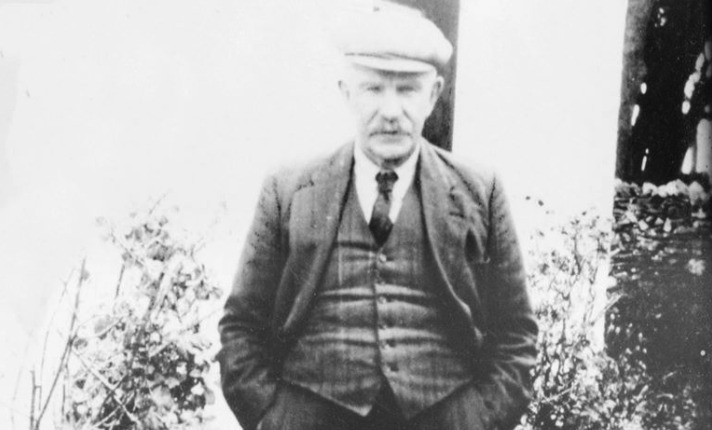
Dakota Goodhouse at Micí MacGabhann's house Éire agus na Chéad Náisiúin
TG4 is proud to present Éire agus Na Chéad Naisiúin, a landmark documentary which uncovers the untold story of Irish interaction with the First Nations of North America, which will feature Donegal-born Micí MacGabhann.
Mac Gabhann was a seanchaí and memoirist from Derryconor, Gortahork. He is best known for his posthumously published Irish diaspora memoir Rotha Mór an tSaoil. The show will air on TG4 on Wednesday, September 17, at 9.30pm.
READ NEXT: West Donegal teen's dreams come true at Electric Picnic festival
At a young age, Mac Gabhann moved to Scotland to work on a potato farm before moving to the United States, in the 1880s.
In the United States, he worked in Montana's mines during the government's expansion in the American West. His work patterns resemble that of many Irish immigrants during the mid-to-late 19th century, who was prompted to move to the west due to their roles in the military, railroad companies, or their search for individual fortune.

Filmed as a road movie across the US, this compelling film offers a dual perspective - examining the Irish immigrant experience through both our own lens and that of the Indigenous peoples impacted by our arrival. This film was produced by Ronin Films with funding from the ILBF and Coimisiún na Meáin.
From trade and war to alliances and betrayal, this film explores the complex and often contradictory roles Irish settlers played in shaping Native American history. Featuring contributions from leading Irish historians and prominent First Nations voices, the documentary sheds light on how Irish emigrants were both the oppressed and the oppressors.
Key stories include that of Sir William Johnson, an 18th-century Irish trader and landowner who forged deep ties with the Mohawk Nation and whose legacy lives on in upstate New York. Viewers will also meet Mohawk elders Kay Olan and Tom Porter, who reflect on Johnson’s role and his lasting impact on their native lands.
The film then journeys from Fort Niagara to the Blackfeet lands of Montana, revealing darker chapters of history—such as the Baker Massacre and the legacy of Irish-American generals like Philip Sheridan and Thomas Francis Meagher, who played central roles in Indigenous displacement.
The film also highlights voices of empathy and understanding. Choctaw artist Waylon Gary White Deer, explores the spiritual and historical connections between the Choctaw Nation and the Irish people, rooted in the shared trauma of dispossession and the famed Choctaw donation during the Great Famine.
Indeed, not all Irish emigrants or their descendants viewed the First Nations as enemies. Some, like Micí MacGabhann, saw striking parallels between Indigenous struggles and the hardships faced in Ireland. Others, such as James Mooney - an American anthropologist born to Irish parents - lived among tribes like the Lakota and recorded their cultural traditions, deeply respecting their efforts to preserve their identity in the face of colonial oppression.
Indigenous resistance, however, brought grave consequences and when gold was discovered in the sacred Black Hills, tensions gave rise to the Great Sioux War of 1876. Many Irish, having emigrated during the Great Famine, struggled to find work in America and enlisted in the US Army.
They would then be tasked with clearing the Indigenous population from their lands. Many fought and died for the U.S. Army at the infamous Battle of Little Bighorn, including Captain Myles Keogh, and many Irish soldiers would again be present at the Wounded Knee Massacre. The last remaining survivor, Hugh McGinnis, would later confess that he was haunted by the horrors that he had witnessed that day.
Éire agus Na Chéad Naisiúin concludes with a poignant reflection by Lakota historian Dakota Wind Goodhouse, drawing parallels between ancient Irish and Lakota traditions and offering a powerful call for reconciliation and remembrance. This is a groundbreaking film that confronts a deep division within the Irish psyche. We were both friends and foes of the Native Americans. Having been exiled from our own land, we settled in theirs.
Subscribe or register today to discover more from DonegalLive.ie
Buy the e-paper of the Donegal Democrat, Donegal People's Press, Donegal Post and Inish Times here for instant access to Donegal's premier news titles.
Keep up with the latest news from Donegal with our daily newsletter featuring the most important stories of the day delivered to your inbox every evening at 5pm.